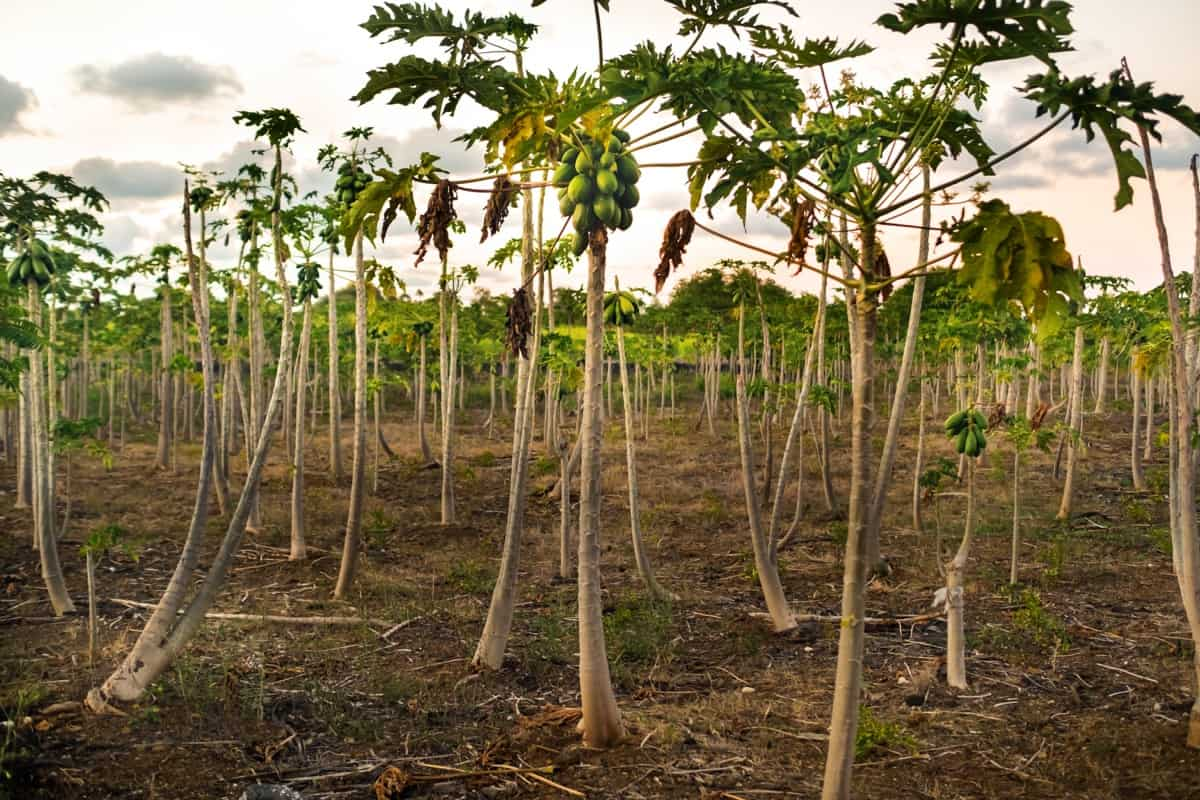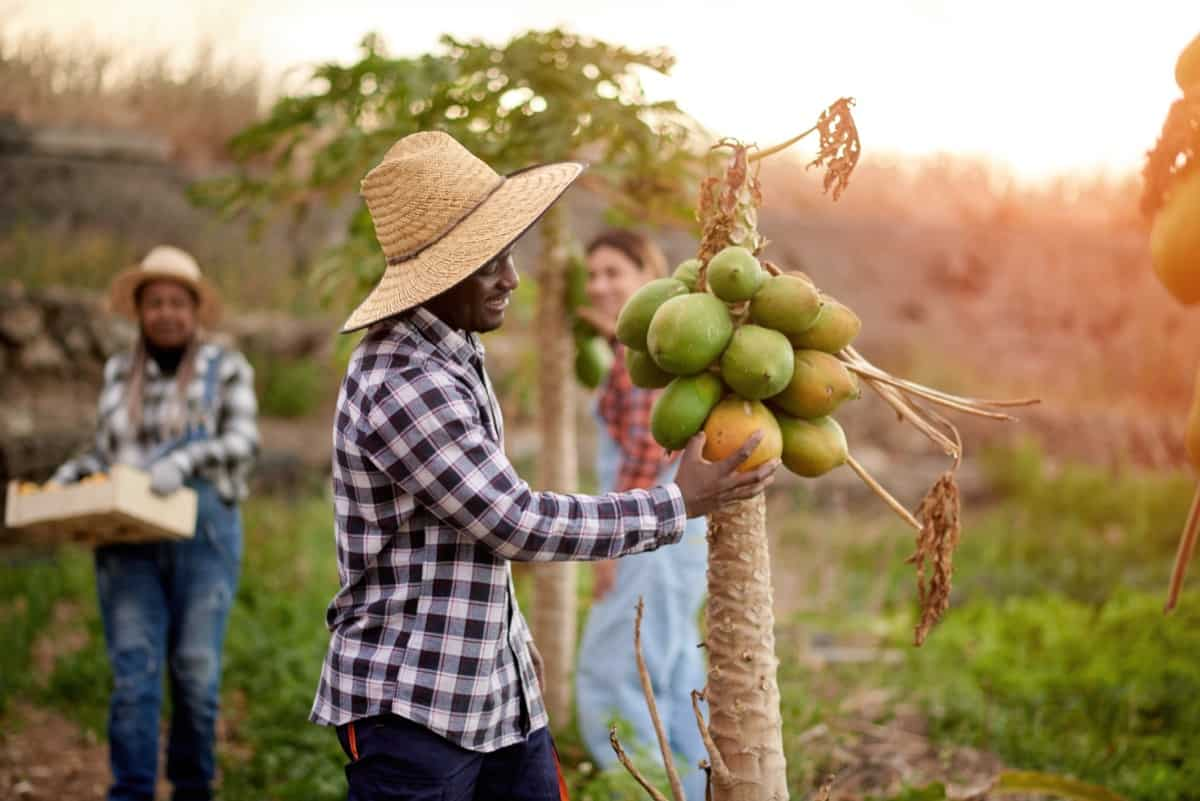Papaya Scientifically known as Carica papaya, pawpaw is a tropical American fruit cultivated for its delicious melon-like fruit. It belongs to the Caricaceae family and can grow up to 25 years, reaching 2–10 m heights. The tree’s gender determines its inflorescence type: male trees bear flowers on long panicles, while females have solitary or clustered yellow-green flowers.

The papaya fruit, a large fleshy berry, features smooth skin that ripens to yellow or orange. The juicy flesh, ranging from yellow to red or orange, houses black wrinkled seeds. Originating from the Caribbean region of Central America, papaya is often replanted every three years for optimal productivity.
How to Manage Pest and Diseases in Papaya
Uses and Benefits of Papaya
Papaya fruits are rich source in vitamins C and A, addressing deficiencies in tropical diets. Immature fruits serve as vegetables in certain regions. The C. papaya tree’s unripe fruits contain papain, which is commercially used to tenderize meat. Papain finds applications in medicine, leather tanning, preventing wool shrinkage, and clarifying beer during brewing.
Propagation and Care in Papaya
Papaya is propagated by seeds, with young plants requiring consistent care, including watering, fertilization, and protection from pests and diseases. Proper pruning ensures healthy growth and higher yields. Disease management involves addressing fungal, bacterial, viral, and oomycete infections, while insect pests can be controlled using appropriate measures.
How to Manage Common Diseases in Papaya
Managing common diseases in papaya involves a multi-faceted approach. For fungal diseases like Anthracnose, use protective fungicides and hot-water dips. Employ similar strategies for Black Rot and Black Spots, focusing on preventing wounds and controlling humidity. Cercospora Black Spot demands regular protective fungicide applications. For Powdery Mildew, remove infected parts, ensure proper nutrition, and apply fungicides.
Combat bacterial diseases like Canker and Decline through protective fungicides. Address Internal Yellowing with a hot-water dip. Manage Bunchy Top by using tolerant papaya varieties. Control Papaya Ringspot by removing infected plants and practicing virus-free planting. Phytophthora Fruit Rot can be mitigated with protective fungicides and careful soil management.
In case you missed it: How to Identify and Treat Crossandra Diseases: Symptoms, Prevention, and Control

- Anthracnose and Charcoal Spot (Colletotrichum gleosporoides): Caused by Glomerellacingulata, this fungal disease leads to circular sunken lesions with light brown margins on papaya fruit. Fungicidal sprays and a 20-minute hot-water dip at 45°C are effective in control. Fungi spread through wind and rain, favored by high temperature and humidity. Management includes using appropriate fungicides and dipping fruits in hot water at 48-50°C for 20 minutes.
- Black Rot (Mycosphaerella caricae): Characterized by black sunken rot on young fruits, this fungal disease enters through wounds. Effective management involves protective fungicides and a 20-minute hot-water dip at 48°C.
- Black Spot (Asperisporium caricae): This fungus causes circular water-soaked lesions on leaves and sunken lesions on fruit. Fungicides and humidity control are recommended.
- Cercospora Black Spot (Cercospora papaya): Tiny black dots enlarge to 3 mm across on fruit, with irregular gray-white lesions on leaves. Protective fungicides are crucial.
- Powdery Mildew (Oidium caricature-papaya): White mycelial growth on leaves and fruits, chlorotic lesions; managed through the removal of infected parts, proper nutrition, and fungicides.
- Bacterial Canker and Decline (Erwinia spp.): Angular water-soaked lesions on leaves, stem cankers; managed with protective fungicides.
- Internal Yellowing (Enterobacter cloacae): Yellow discolored ripe fruit with soft, spreading areas; manage with hot-water dip at 48°C.
- Bunchy Top (Likely caused by Rickettsia bacteria): Chlorosis of leaves, water-soaked spots, stunted growth; manage with tolerant varieties.
Papaya Diseases: Symptoms and Disease Spread
Foot Rot Disease Management in Papaya
Water-soaked patches on the stem near ground level enlarge, causing rot and turning tissues dark brown or black. Affected plants topple over and die. Mild cases lead to stunted growth and shriveled, malformed fruits. Resting spores (oospores) germinate, releasing zoospores that spread via irrigation water. High humidity and rain promote severe disease development in infected soil.
Anthracnose Disease Management in Papaya
Fruits develop brown superficial spots and turn circular and slightly sunken. Salmon pink spores appear under humidity. The early infection leads to mummification and deformation. Spread by wind-borne conidia and rain splashes. Excessive moisture on foliage worsens the disease. High humidity and temperatures around 26°C during wet weather support disease growth.
Powdery Mildew Disease Management in Papaya
The underside of leaves develops whitish powder; upper surfaces show yellow patches near veins, sometimes covering the leaf. Infected fruits are small and deformed. The fungus overwinters in buds, releasing spores in spring to cause new infections. Relative humidity of 80-85% and 24-26°C temperatures facilitate powdery mildew development.
Papaya Ring Spot Disease Management in Papaya
Young leaves show chlorosis, vein clearing, and mottling. Infected fruits display concentric rings causing yield loss. The virus is aphid-transmitted. Aphid transmission is more active in warmer conditions.
Papaya Mosaic Disease Management in Papaya
Leaves exhibit mosaic, stunting, and distortion. Young leaves show dark-green patches alternating with yellowish-green tissue. The virus is aphid-borne. Mechanically transmissible and aphid-borne, with a restricted host range to papaya and cucurbits.
In case you missed it: How to Identify and Manage Common Crossandra Pests: Damage Symptoms, Prevention, and Control

Papaya Leaf Curl Disease Management in Papaya
Leaves curl, crinkle, and distort, turning leathery and brittle. The whitefly-transmitted virus causes stunted growth and no flowering or fruiting. Transmitted by Silverleaf whitefly, Bemisia tabaci. Viruses cannot be transferred mechanically.
How to Control Common Pests in Papaya
Papaya Mealybug (Paracoccus marginatus) infestation poses a significant threat to papaya plants. These flattened oval insects, covered in a cottony substance, sap nutrients from the tree. This attack leads to chlorosis, stunted growth, leaf deformation, and premature leaf and fruit drop. Ants, which farm the mealybugs for their sugary excretions, often accompany them. The infestation can also attract sooty mold, which grows on the honeydew secretions produced by the insects.
Mealybugs have a broad host range and can transmit Cocoa Swollen Shoot Virus. Managing this pest involves a dual approach. Natural predators like ladybeetles can help control populations, but chemical pesticides are commonly used. However, caution is advised, as chemical treatments can harm beneficial insects, potentially leading to mealybug outbreaks. White Peach Scale (Pseudaulacaspis pentagona) is another threat to papaya trees.
These disc-shaped insects attach themselves to twigs, branches, and fruit, injecting toxins while feeding. This feeding can cause gumming on bark, twig death, and even branch loss. The scales secrete a white waxy substance that turns black over time. Natural enemies like predacious beetles and wasps often control scale populations. However, broad-spectrum insecticides can disrupt this balance, resulting in scale outbreaks. Dormant trees can be treated with horticultural oils that target scales without harming beneficial insects.
In case you missed it: How to Identify and Treat Croton Diseases: Damage Symptoms, Prevention, and Control

Conclusion
Early identification of symptoms is crucial to effectively managing pests and diseases in papaya. Consider their impact on natural predators using appropriate treatments, such as fungicides or pesticides. Implement preventive measures like maintaining proper hygiene and planting disease-resistant varieties. Regular monitoring and a balanced approach are key to sustaining healthy papaya cultivation.
- Deworming Schedule for Dogs/Puppies: A Beginners Guide
- How to Prevent and Control Parasites in Goats
- Beneficial Insects in Pest Management
- Natural Solutions for Pest Control in Flower Gardens
- Types of Fungicides Used in Agriculture
- Common Issues in the Fruit Development Stage of Pomegranate Farming
- Fruit Development Issues in Papaya: Easy Solutions and Treatment
- Soil-Borne Diseases and How to Protect Your Plants
- Practices to Prevent Disease Spread in the Garden